I recently ordered the “Early Simple Machines III” kit from Lego Education, (also available from Amazon)
What’s in the kit:
There are 102 Duplos, including some unique specialty pieces, plus eight instruction cards with visual instruction for how to assemble 8 machines.
There is also a teacher’s guide PDF that you can download (although the directions about how to do this weren’t clear to me when I received the box). The teacher’s guide has 8 lessons, each with 4 sections:
- Connect: a short story featuring the characters Sara and Sam and introducing a problem they want to solve or activity they saw that they want to re-create (e.g. they saw children playing with spinning tops and want to build their own)
- Construct: includes tips for how to build the project or trouble-shoot student creations to ensure they’re working correctly
- Contemplate: guides children through brief experiments to do with the item they created, and compare test results. Includes worksheets to guide children. Questions are offered to extend children’s learning. (e.g. which top design spins faster? Will the boat move faster with a smaller sail or a bigger sail?)
- Continue: ideas for further investigation (e.g. make your own pinwheel wings from paper, or design your own sail for the boat)
The set is rated as appropriate for ages 5 and up. I think 4 and up would do fine if the child has prior experience with Duplos and Legos, and with STEM concepts.
Note: at $149.95 this is not a cheap product, at least from my perspective as a non-profit class with a limited budget. If you have more funds available and want to buy multiple packs, there is some discount for buying in bulk: https://education.lego.com/en-us/products/early-simple-machines-classroom-packs/prod120002
Using the kit – options
8 sequential lessons. Whether in a classroom setting, or using these at home with your child, you can start with project #1 and work your way through to project #8, following the directions. You could use the teacher’s guide, walking kids through the story, constructing, testing with the worksheets, and continuing on with additional work. After completing the full curriculum, then the materials could be left out for free play and exploration.
Occasional classroom activity. For our inventors class, I plan to put these projects out one at a time, as they tie into the theme of the week. The project will be one of many activity stations in the room that the children can rotate to independently. I will put out the instructions card, then put all the materials they need for the project in one basket, and some extra Duplos nearby in case they want to tinker / add to the project after they’ve completed it. I will typically not use the activities and materials in the teachers’ guide, except occasionally the worksheets or the questions that extend learning.
The projects
#1 is a pinwheel, which spins when you blow on it. We’ll add it to our Wind theme class.
Project #2 involves building a top launcher, where you turn the crank, which spins the gears to wind up the top, then you release the top which spins and spins. This is actually a VERY cool Duplo set, and “worth the price of admission.” We’ll add it to our week where we talk about wheels and axles.
Note: although the instructions don’t tell you this, I think it would be fun to first have children build the top, and try spinning it with their hands to see how long it will spin, and then make the launcher and test again. Helps them really understand the power of the gears to increase spin.
#3 is a seesaw. It’s fun because you can move the Duplo people back and forth to balance them, or you can try adding other Duplo loads and finding the balance point – it’s overall a helpful lever to add to our Levers class for fun exploration.
#4 is a raft. After my 5 year old and I built it, I was curious whether it would float or not. We talked about what he knew about what sinks and what floats: It was broad and flat, and he knows that’s a shape that tends to float well. It had a solid bottom – he knows you want to avoid holes in the bottom of a boat that would cause it to take on water and sink. Legos are pretty light, he thought, but are they light enough? He couldn’t decide if it would float or not. I predicted it would. His dad predicted it wouldn’t – he didn’t think it could capture enough air underneath it to float. It turns out it could, and it did float. So, we decided ten and there that this project will be saved till our Sink and Float class, where we’ll ask our students to make the same assessments and predictions.
Ironically, after we did all this, we read the teacher’s guide. 🙂 Turns out the “contemplate” experiment has you float the boat on water, and then blow into the sail to see how fast it will travel with a small sail or a large one.
#5 is a car and a launcher
The Connect story in the teacher’s guide is that Sam and Sara love racing their car down the hill, but hate the hard work of pushing it back up the hill again. In the Construct part of the teacher’s guide, you build the car, two launchers, and the ramp (by propping a board on a stack of books or blocks.) In the Contemplate section, you test whether the small launcher or the big launcher is better at getting the car back up the ramp. The Continue section is about competing for accuracy… who can launch the car so it reaches a target but doesn’t overshoot it. We will use this in our Cars week, which follows the wheels and axles unit. We will likely include the Connect story in class, because it illustrates nicely how a simple machine reduces the human work required.
This is a cool project, and I worry a little that having only one car in the classroom may lead to some squabbles that day over who gets to play with it…
#6 is a measuring car. As it drives forward, the pointer turns, measuring (non-standard) units travelled. Students are asked to predict how far the car will travel depending on how steep the ramp is. This car could be used in a class with a Measurement theme, but we won’t be doing that theme this year, as we found that it was over the heads of our 3 – 4 year olds. It could also fit in Contraptions, which is late in our Engineering / Simple Machines unit. I’m going to use it in the Cars week, to reduce the predicted squabbles I mentioned above…
#7 is a hockey playing robot. You turn a gear on his back, and he swings his stick at a block. We’ll add him to our Robot week.
#8 is a goofy dog whose eyes spin. We’ll add him to our Contraptions week, which is late in our Engineering / Simple Machines unit. I’ll have just his materials out during Discovery time at the beginning of class, but in tinkering time, I’ll probably make lots more of the supplies from this Simple Machines kit out so children can incorporate them into contraptions.
Note: This is called a Simple Machines kit, so I was expecting a little closer tie-in to the concept of the 6 Simple Machines. Perhaps one project to illustrate each machine, then a couple that blend them together. The seesaw does this for the lever, and several of them are about wheels and axles. Those cars are tested on an inclined plane, but the curriculum doesn’t talk about this as a simple machine idea. I’m not sure what Duplo project would tie into screws or wedges, so am not surprised those aren’t represented, but I would have expected something including a pulley. This isn’t a complaint, per se. I really like the projects that they did include, but want to be sure that others are aware of what they are / aren’t getting.
Overall, although this is a pricey purchase for us, I look forward to incorporating these projects in our Inventors Lab over the course of the year. A lot of what we do in the class is very process oriented, without clear instructions for how the activity SHOULD be done. Adding these instruction-based projects into the mix helps to teach a different kind of skill to the kids. (And, of course, we’ll always have lots of process-based building activities available in all classes.)

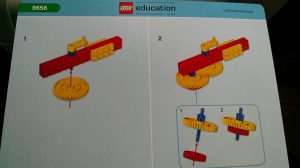

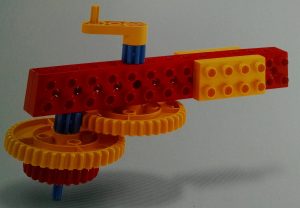
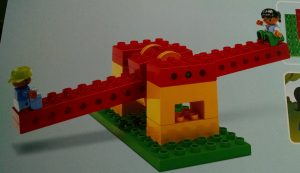
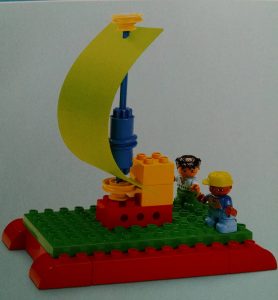
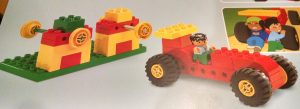
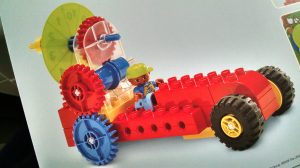
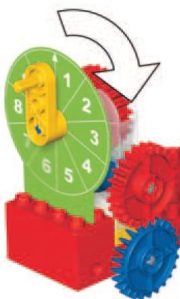
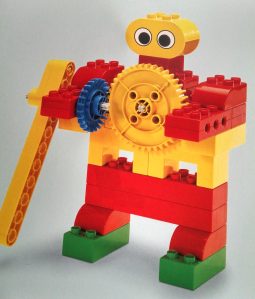
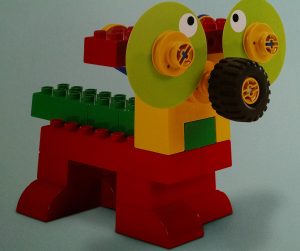
[…] Duplo Simple Machines Kit […]
LikeLike
[…] Duplo Simple Machines Kit […]
LikeLike
[…] Duplo Simple Machines Kit […]
LikeLike
[…] Duplo Simple Machines Kit […]
LikeLike
[…] Duplo Simple Machines Kit […]
LikeLike
[…] Duplo Simple Machines Kit […]
LikeLike
[…] Duplo Simple Machines Kit […]
LikeLike
[…] Duplo Simple Machines Kit […]
LikeLike
[…] thread, and a plastic cup. Note: this requires some specialty Duplo pieces which we got from our Duplo Simple Machines pack. A pulley lifts the bucket up out of the water. These are views of the full well, the front of the […]
LikeLike
[…] Early Simple Machines III. I have a full review of this kit here. Quick summary is that it’s a great kit, with some really fun projects (some not as […]
LikeLike
[…] Activity: We put out this Duplo seesaw […]
LikeLike
[…] We also put out this cool Duplo top launcher, already assembled, plus directions on how to build it, so kids had the option of taking it apart […]
LikeLike
[…] also put out one of these two Duplo car projects: the Duplo car launcher, and the Measuring Car. Some children would take apart the Duplo project […]
LikeLike
[…] practice following directions to achieve a pre-designed result. This week we put out the full Simple Machines kit for them to do free designing […]
LikeLike
[…] Contraptions | Inven… on Duplo Simple Machines Kit […]
LikeLike
[…] Hockey Robot: We put out one of the sets from the Duplo simple machines kit. I like using Duplo kits in class, because the older kids can practice following pictorial […]
LikeLike
[…] year, we’ll add in this Duplo raft […]
LikeLike
[…] a robot with Duplos or Legos. I like this project from the Duplo simple machines kit. I like using Duplo kits in class, because the older kids can practice following pictorial […]
LikeLike
Thanks for the excellent review .
I was wondering which one will be better for my 5 year old son.
This 9656 set or some simple technic set coupled with klutz lego crazy contraptions ?
LikeLike
This set is good for a typical 5-7 year old. Klutz contraptions is 7+ and most technic is 8+. In my experience lego age estimates are “if we say 8+, that means an 8 year old can do it with occasional help from parents.” So, a 5 year old would basically be assisting a parent with an 8+ set
LikeLike
[…] Activity: We put out this Duplo seesaw […]
LikeLike
[…] also put out the Duplo pinwheel kit, which encourages children to try following directions to build a pre-designed project, and a […]
LikeLike